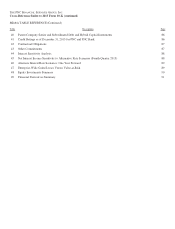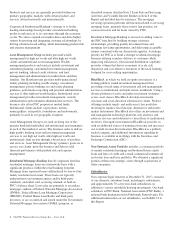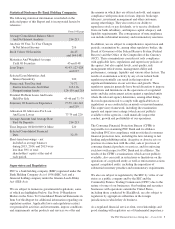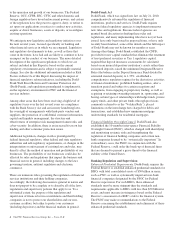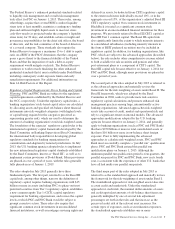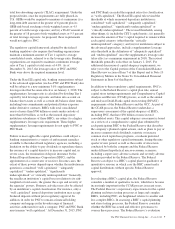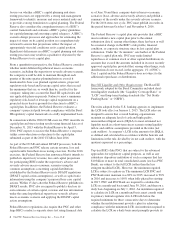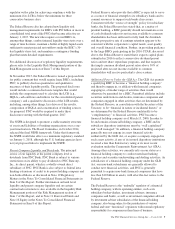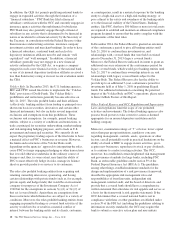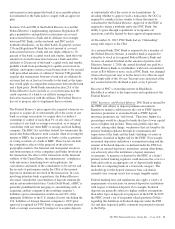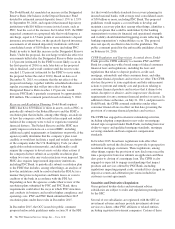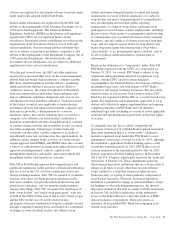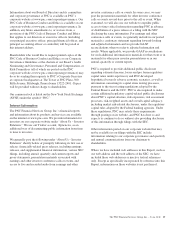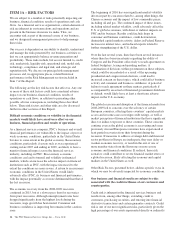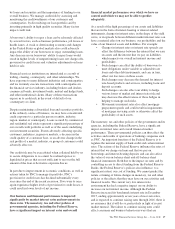PNC Bank 2015 Annual Report Download - page 25
Download and view the complete annual report
Please find page 25 of the 2015 PNC Bank annual report below. You can navigate through the pages in the report by either clicking on the pages listed below, or by using the keyword search tool below to find specific information within the annual report.total loss-absorbing capacity (TLAC) requirement. Under the
proposed rules, once the requirements are fully phased-in,
U.S. GSIBs would be required to maintain at a minimum (i) a
long-term debt amount of the greater of 6 percent plus its
GSIB risk-based surcharge of risk-weighted assets or 4.5
percent of total leverage exposure; and (ii) a TLAC amount of
the greater of 18 percent of risk-weighted assets or 9.5 percent
of total leverage exposure. As proposed, these requirements
would not apply to PNC.
The regulatory capital framework adopted by the federal
banking regulators also requires that banking organizations
maintain a minimum amount of Tier 1 capital to average
consolidated assets, referred to as the leverage ratio. Banking
organizations are required to maintain a minimum leverage
ratio of Tier 1 capital to total assets of 4.0%. As of
December 31, 2015, the leverage ratios of PNC and PNC
Bank were above the required minimum level.
Under the Basel III capital rule, banking organizations subject
to the advanced approaches (such as PNC and PNC Bank) also
will be subject to a new minimum 3.0% supplementary
leverage ratio that becomes effective on January 1, 2018. The
supplementary leverage ratio is calculated by dividing Tier 1
capital by total leverage exposure and takes into account on
balance sheet assets as well as certain off-balance sheet items,
including loan commitments and potential future exposure
under derivative contracts. BHCs with total consolidated
assets of more than $700 billion or assets under custody of
more than $10 trillion, as well as the insured depository
institution subsidiaries of these BHCs, are subject to a higher
supplementary leverage ratio requirement. These higher
supplementary leverage requirements do not apply to PNC or
PNC Bank.
Failure to meet applicable capital guidelines could subject a
banking organization to a variety of enforcement remedies
available to the federal bank regulatory agencies, including a
limitation on the ability to pay dividends or repurchase shares,
the issuance of a capital directive to increase capital and, in
severe cases, the termination of deposit insurance by the
Federal Deposit Insurance Corporation (FDIC), and the
appointment of a conservator or receiver. In some cases, the
extent of these powers depends upon whether the institution in
question is considered “well capitalized,” “adequately
capitalized,” “undercapitalized,” “significantly
undercapitalized” or “critically undercapitalized.” Generally,
the smaller an institution’s capital base in relation to its risk-
weighted or total assets, the greater the scope and severity of
the agencies’ powers. Business activities may also be affected
by an institution’s capital classification. For instance, only a
“well capitalized” insured depository institution may accept
brokered deposits without prior regulatory approval. In
addition, in order for PNC to remain a financial holding
company and engage in the broader range of financial
activities authorized for such a company, PNC and PNC Bank
must remain “well capitalized.” At December 31, 2015, PNC
and PNC Bank exceeded the required ratios for classification
as “well capitalized.” The Basel III capital rule revised the
thresholds at which an insured depositary institution is
considered “well capitalized,” “adequately capitalized,”
“undercapitalized,” “significantly undercapitalized” or
“critically undercapitalized.” The revised thresholds, among
other things, (i) include the CET1 capital metric; (ii) generally
increase the amount of Tier 1 capital required to remain within
each capital category (other than the “critically
undercapitalized” category); and (iii) for institutions subject to
the advanced approaches, include a supplementary leverage
ratio threshold in the definitions of “adequately capitalized”
and “undercapitalized” once the supplementary leverage ratio
takes effect as a minimum requirement in 2018. The revised
thresholds generally took effect on January 1, 2015. For
additional discussion of capital adequacy requirements, we
refer you to the Capital portion of the Consolidated Balance
Sheet Review section of Item 7 of this Report and to Note 19
Regulatory Matters in the Notes To Consolidated Financial
Statements in Item 8 of this Report.
In addition to these regulatory capital requirements, PNC is
subject to the Federal Reserve’s capital plan rule, annual
capital stress testing requirements and Comprehensive Capital
Analysis and Review (CCAR) process, as well as the annual
and mid-year Dodd-Frank capital stress testing (DFAST)
requirements of the Federal Reserve and the OCC. As part of
the CCAR process, the Federal Reserve undertakes a
supervisory assessment of the capital adequacy of BHCs,
including PNC, that have $50 billion or more in total
consolidated assets. This capital adequacy assessment is based
on a review of a comprehensive capital plan submitted by
each participating BHC to the Federal Reserve that describes
the company’s planned capital actions, such as plans to pay or
increase common stock dividends, reinstate or increase
common stock repurchase programs, or redeem preferred
stock or other regulatory capital instruments, during the nine
quarter review period, as well as the results of stress tests
conducted by both the company and the Federal Reserve
under different hypothetical macro-economic scenarios,
including a supervisory adverse scenario and severely adverse
scenario provided by the Federal Reserve. The Federal
Reserve can object to a BHC’s capital plan for qualitative or
quantitative reasons, in which case the BHC cannot make
capital distributions without specific Federal Reserve
approval.
In evaluating a BHC’s capital plan, the Federal Reserve
considers a number of qualitative factors, which have become
increasingly important in the CCAR process in recent years.
The Federal Reserve’s supervisory expectations for the capital
planning and stress testing processes at large and complex
BHCs, including PNC, are heightened relative to smaller and
less complex BHCs. In assessing a BHC’s capital planning
and stress testing processes, the Federal Reserve considers
whether the BHC has sound and effective governance to
oversee these processes. The Federal Reserve’s evaluation
The PNC Financial Services Group, Inc. – Form 10-K 7


